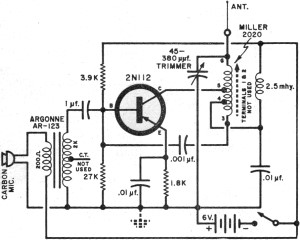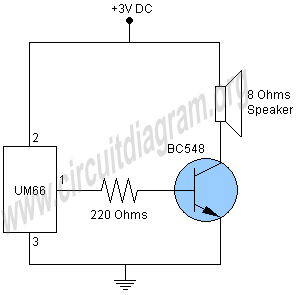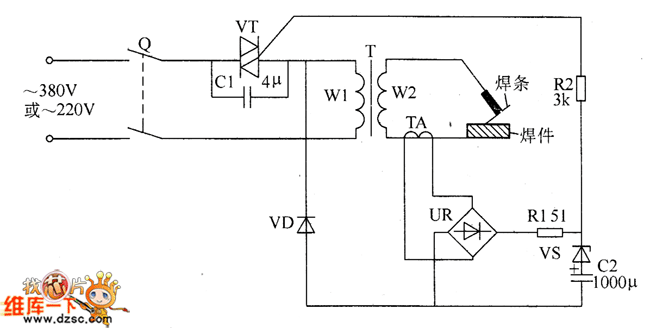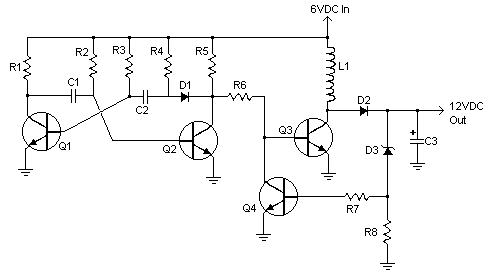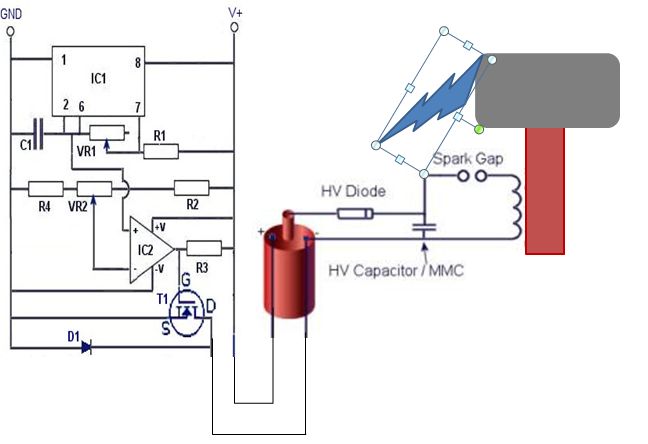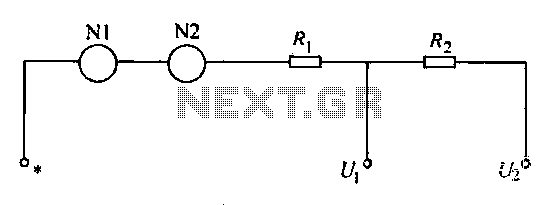
MINI PIEZO SIREN circuit
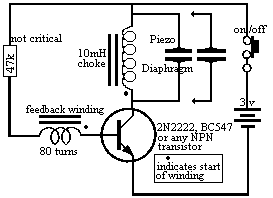
The piezo diaphragm can originate from a music card, and if two or three diaphragms are available, they can be connected in parallel, as illustrated in the diagram, to observe their impact on the output frequency. The only component that needs to be fabricated is the transformer. The circuit employs a transistor to drive the piezo. When discussing the operation of a transistor, it refers to transistor action, which is the amplification of the current entering the base, allowing a larger current to flow through the collector-emitter circuit. Transistor action is synonymous with transistor amplification. The circuit also illustrates transformer action, where the component across the piezo diaphragm acts as an inductor with an over-wind, providing positive feedback to the base of the transistor. These two windings demonstrate transformer action, where a waveform in one winding is transferred to another via electromagnetism, produced by electrical current. The transistor amplifies the base current, resulting in a higher current flowing in the collector-emitter circuit. The ratio of these currents represents the transistor's gain, typically around 100, but it can range from 20 to over 400, depending on the transistor type and surrounding circuit components. The transistor's base bias resistor is configured to partially turn the transistor on, allowing a moderate current to flow through the collector-emitter circuit. Connected to the collector is an inductor, which consists of wire wound on a ferrite core. Ferrite is a material where iron particles are insulated from each other, enabling magnetic separation. When current flows through the winding, it generates expanding magnetic flux, which cuts through the feedback winding. This feedback winding is linked to the transistor's base, augmenting the current supplied by the base-bias resistor and increasing the base current. The current continues to rise until the transistor is fully on, at which point the magnetic flux reaches its maximum but is not expanding. Only the expanding flux induces current in the feedback winding, and stationary magnetic flux does not induce current, leading to a reduction in current through the base of the transistor. Consequently, the transistor slightly turns off, although the base-bias resistor continues to provide a small current. As the current through the inductor decreases, the magnetic flux also diminishes, resulting in a collapsing magnetic field that induces a current of opposite polarity in the feedback winding. The number of turns on the feedback winding is determined by winding enough turns for circuit functionality, then gradually removing turns until the circuit fails, followed by adding a few turns to ensure proper operation. The energy from the feedback winding must be sufficient to sustain oscillation. In the context of the circuit, a piezo acts as a capacitor with a capacitance of approximately 10nF to 20nF. The inductor and capacitor together form a tuned circuit or parallel resonant circuit.
The described circuit is a classic example of a piezoelectric oscillator, utilizing a transistor to amplify the signal generated by the piezo diaphragm. The piezo diaphragm, acting as a capacitive element, converts mechanical vibrations into electrical signals. When multiple diaphragms are connected in parallel, their combined capacitance increases, which can significantly affect the resonant frequency of the circuit.
The transistor's role is crucial, as it serves as a switch and amplifier. When a small input current is applied to the base via the bias resistor, it allows a larger current to flow from the collector to the emitter. This action is amplified as the feedback winding induces additional current into the base, creating a regenerative feedback loop that sustains oscillation. The feedback mechanism is essential for maintaining continuous oscillation, as it ensures that the transistor remains in an active state.
The inductor, wound around a ferrite core, plays a significant role in the circuit's operation. The ferrite core enhances the magnetic coupling and allows for efficient energy transfer between the windings. The design of the feedback winding is critical; it must be optimized to ensure that the induced current is sufficient to keep the transistor in its active region without causing saturation.
The oscillation frequency of the circuit can be fine-tuned by adjusting the values of the piezo capacitance and the inductor's inductance. The parallel resonant circuit formed by the piezo and inductor allows for selective frequency response, making the circuit suitable for applications requiring specific frequency outputs, such as sound generation in musical devices.
Overall, this circuit exemplifies the principles of electronics involving transistors, inductors, and capacitors, illustrating the interplay between these components to achieve desired electrical characteristics and functionalities.The piezo diaphragm can come from a music card and if you have two or three diaphragms, they can be added in parallel-as shown on the diagram to see how they affect the frequency of the output. The only component you will have to make is the "transformer. " The circuit uses a transistor to drive a piezo and when we discuss the operation of a transistor we are describing TRANSISTOR ACTION. This is the action of a transistor amplifying the current entering the base and allowing a larger current to flow through the collector-emitter circuit. TRANSISTOR ACTION is simply another name for TRANSISTOR AMPLIFICATION. The circuit also demonstrates TRANSFORMER ACTION (the component across the piezo diaphragm is essentially an inductor with an over-wind to supply positive feedback to the base of the transistor).
These two windings demonstrate TRANSFORMER ACTION (the action of a waveform in one winding being passed to another winding. The waveform is passed via electro-magnetism - a magnetic field - and this is magnetism produced by electrical current.
) Transistor action is simply the amplifying action of the transistor. A transistor amplifies the current entering the base and causes a higher current to flow in the collector-emitter circuit. The ratio of these two is the gain of the transistor and is generally about 100, however the gain can range from 20 to 400 or more, depending on the type of transistor and the value of the surrounding circuit components.
The transistor amplifies the current about 100 times and allows the higher current to flow in the collector-emitter circuit. This is called TRANSISTOR ACTION or TRANSISTOR AMPLIFICATION. The base bias resistor is designed to partially turn the transistor ON and this causes a medium amount of current to flow through the collector-emitter circuit.
Connected to the collector is a coil of wire called an inductor. The wire is wound on a ferrite core. Ferrite is an iron material in which the particles of iron are surrounded by an insulating material so that the iron particles are magnetically separate. When current passes through the winding it produces EXPANDING MAGNETIC FLUX and this flux cuts the turns of the winding we have added, called the feedback winding.
This feedback winding is connected to the base of the transistor so that the current it produces is ADDED to the current supplied by the base-bias resistor and this causes a greater current to flow in the base of the transistor. The current continues to increase until the transistor is fully turned on and at this point in the cycle the flux is a maximum but it is NOT EXPANDING.
Only expanding flux cuts the turns of the feedback winding and produces a current in it. Stationary magnetic flux does not produce (induce) a current in the over-wind and thus the current produced by the feedback winding ceases. This causes less current to flow in the base of the transistor and the transistor turns off a slight amount (don`t forget, the base-bias resistor is still providing a small amount of turn-on current).
The current through the inductor reduces and the flux begins to reduce. This causes a collapsing magnetic field to be present and this flux cuts the feedback winding to produce a current in it of opposite polarity. The number of turns on the feedback winding is worked out by winding sufficient turns to get the circuit to work then removing a few at a time until the circuit fails to work.
A few turns are then added to guarantee operation. The energy from the feedback winding must be enough to maintain oscillation. As far as the circuit is concerned, a piezo is a capacitor of about 10n to 20n. The inductor and capacitor form a tuned circuit or PARALLEL RESONANT CIRCUIT and if the piezo is remo 🔗 External reference
The described circuit is a classic example of a piezoelectric oscillator, utilizing a transistor to amplify the signal generated by the piezo diaphragm. The piezo diaphragm, acting as a capacitive element, converts mechanical vibrations into electrical signals. When multiple diaphragms are connected in parallel, their combined capacitance increases, which can significantly affect the resonant frequency of the circuit.
The transistor's role is crucial, as it serves as a switch and amplifier. When a small input current is applied to the base via the bias resistor, it allows a larger current to flow from the collector to the emitter. This action is amplified as the feedback winding induces additional current into the base, creating a regenerative feedback loop that sustains oscillation. The feedback mechanism is essential for maintaining continuous oscillation, as it ensures that the transistor remains in an active state.
The inductor, wound around a ferrite core, plays a significant role in the circuit's operation. The ferrite core enhances the magnetic coupling and allows for efficient energy transfer between the windings. The design of the feedback winding is critical; it must be optimized to ensure that the induced current is sufficient to keep the transistor in its active region without causing saturation.
The oscillation frequency of the circuit can be fine-tuned by adjusting the values of the piezo capacitance and the inductor's inductance. The parallel resonant circuit formed by the piezo and inductor allows for selective frequency response, making the circuit suitable for applications requiring specific frequency outputs, such as sound generation in musical devices.
Overall, this circuit exemplifies the principles of electronics involving transistors, inductors, and capacitors, illustrating the interplay between these components to achieve desired electrical characteristics and functionalities.The piezo diaphragm can come from a music card and if you have two or three diaphragms, they can be added in parallel-as shown on the diagram to see how they affect the frequency of the output. The only component you will have to make is the "transformer. " The circuit uses a transistor to drive a piezo and when we discuss the operation of a transistor we are describing TRANSISTOR ACTION. This is the action of a transistor amplifying the current entering the base and allowing a larger current to flow through the collector-emitter circuit. TRANSISTOR ACTION is simply another name for TRANSISTOR AMPLIFICATION. The circuit also demonstrates TRANSFORMER ACTION (the component across the piezo diaphragm is essentially an inductor with an over-wind to supply positive feedback to the base of the transistor).
These two windings demonstrate TRANSFORMER ACTION (the action of a waveform in one winding being passed to another winding. The waveform is passed via electro-magnetism - a magnetic field - and this is magnetism produced by electrical current.
) Transistor action is simply the amplifying action of the transistor. A transistor amplifies the current entering the base and causes a higher current to flow in the collector-emitter circuit. The ratio of these two is the gain of the transistor and is generally about 100, however the gain can range from 20 to 400 or more, depending on the type of transistor and the value of the surrounding circuit components.
The transistor amplifies the current about 100 times and allows the higher current to flow in the collector-emitter circuit. This is called TRANSISTOR ACTION or TRANSISTOR AMPLIFICATION. The base bias resistor is designed to partially turn the transistor ON and this causes a medium amount of current to flow through the collector-emitter circuit.
Connected to the collector is a coil of wire called an inductor. The wire is wound on a ferrite core. Ferrite is an iron material in which the particles of iron are surrounded by an insulating material so that the iron particles are magnetically separate. When current passes through the winding it produces EXPANDING MAGNETIC FLUX and this flux cuts the turns of the winding we have added, called the feedback winding.
This feedback winding is connected to the base of the transistor so that the current it produces is ADDED to the current supplied by the base-bias resistor and this causes a greater current to flow in the base of the transistor. The current continues to increase until the transistor is fully turned on and at this point in the cycle the flux is a maximum but it is NOT EXPANDING.
Only expanding flux cuts the turns of the feedback winding and produces a current in it. Stationary magnetic flux does not produce (induce) a current in the over-wind and thus the current produced by the feedback winding ceases. This causes less current to flow in the base of the transistor and the transistor turns off a slight amount (don`t forget, the base-bias resistor is still providing a small amount of turn-on current).
The current through the inductor reduces and the flux begins to reduce. This causes a collapsing magnetic field to be present and this flux cuts the feedback winding to produce a current in it of opposite polarity. The number of turns on the feedback winding is worked out by winding sufficient turns to get the circuit to work then removing a few at a time until the circuit fails to work.
A few turns are then added to guarantee operation. The energy from the feedback winding must be enough to maintain oscillation. As far as the circuit is concerned, a piezo is a capacitor of about 10n to 20n. The inductor and capacitor form a tuned circuit or PARALLEL RESONANT CIRCUIT and if the piezo is remo 🔗 External reference
